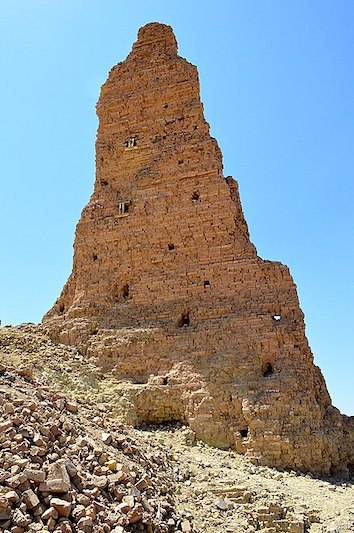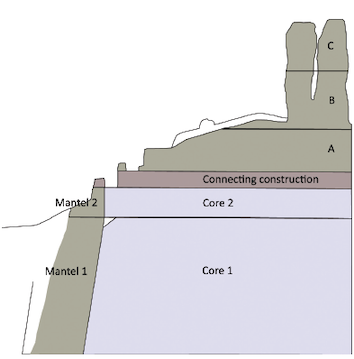Eurmeiminanki (ziggurat of Nabû at Borsippa)

The ruins of the so-called "Tongue Tower" of Eurmeiminanki at Borsippa. Photograph by Osama Shukir Muhammed Amin.
Up until the mid-nineteenth century, the ruins of the brick core of Borssipa's ziggurat were wrongly believed to have been the fabled biblical Tower of Babel, whose creation described in Genesis 11:1–9 was meant to explain why the world's population spoke many different languages. Instead, the remains of that once-tall, massive, and multi-tiered structure was Eurmeiminanki, the ziggurat of the god Nabû, and not those of the ziggurat Etemenanki, the temple-tower of the god Marduk at Babylon.
Names and Spellings
Borsippa's ziggurat went by the Sumerian ceremonial name Eurmeiminanki, which means "House Which Gathers the Seven Mes of Heaven and Netherworld." This name is attested in the "Kuyunjik Ziggurat List," the "Neo-Babylonian Ziggurat List," Neo-Babylonian royal inscriptions, and liturgical texts.
- Written Forms: e₂-ur-imin-an-ki; e₂-ur₃-me-imin-an-ki; e₂-ur₄-imin-an-ki; e₂-ur₄-me-im-in-an-ki; e₂-ur₄-me-imin-an-ki.
Known Builders
- Neo-Babylonian (ca. 625–539 BC)
- Nebuchadnezzar II (r. 604–562 BC)
- Nabonidus (r. 555–539 BC)
Building History
Virtually nothing about the building history of Eurmeiminanki is known from extant cuneiform sources, except for work undertaken in the Neo-Babylonian Period. Several inscriptions of Nebuchadnezzar II, the most famous ruler of the Neo-Babylonian Empire, record that the ziggurat was is in a bad state of preservation when he came to the throne, describing the dilapidating remains of the building as follows:
Following Babylonian tradition, Nebuchadnezzar does not name any of the previous rulers who had sponsored construction on Eurmeiminanki. It is clear from the archaeological record that Borsippa's temple-tower already existed in the second millennium BC, long before Nebuchadnezzar became king at the end of the sixth century BC. Which Babylonian (and Assyrian) rulers founded and rebuilt that ziggurat cannot yet be confirmed today given the near complete lack of textual evidence. As with Etemenanki, Marduk's ziggurat at Babylon, Nebuchadnezzar boasts that he raised the brick superstructure of Eurmeiminanki and decorated the temple on top of it with blue-glazed baked bricks. A few of the inscribed objects (multi-columned clay cylinders) that this king claims to have deposited in this ziggurat's structure have survived to this day.
Nabonidus, Babylon's last native king, also worked on Eurmeiminanki. According to one inscription of his, he did not work on the ziggurat itself, but on that building's enclosure walls. That same text states that Neriglissar (r. 559–556 BC), a king who ruled Babylon shorty before Nabonidus, worked on the neighboring/connecting enclosure wall of Ezida, which is said to have been unfinished at the time Nabonidus turned his attention to building activities in Borsippa.
Archaeological Remains

Half of the northwest–southeast section of the ziggurat Eurmeiminanki, with the mudbrick cores of three or four terraces and the backed-brick outer mantel of the lower terrace. Adapted from O. Pedersén, Babylon: The Great City, fig. 4.17.
Parts of the mudbrick core and baked-brick outer mantel of the lower terrace and parts of the unbaked brick core of several upper terraces (likely the second, third, and fourth tiers) of the ziggurat survive today; the so-called "Tongue Tower," the core of the upper part of Eurmeiminanki, is preserved to a height of 52 m. Like Etemenanki at Babylon, Eurmeiminanki's lowest tier probably measured 90×90 m, consisting of a 60×60 m inner core of unbaked bricks and a 15-m-thick baked-brick outer mantel; the proposed width of the outer casing is highly likely, but cannot yet be confirmed. The 21-m-high lower terrace roughly corresponds with the 42-cubit-high, incomplete ziggurat mentioned by Nebuchadnezzar II in several of his inscriptions as being started by an unnamed previous king; Assyria's last great king, Ashurbanipal (r. 668–ca. 631 BC), is a likely candidate since uninscribed/unstamped bricks measuring 36×36 cm were found in the lower part of the building. It is unknown how many tiers Eurmeiminanki had during the Neo-Babylonian Period and how high the temple-tower stood after Nebuchadnezzar II completed its construction. Based on the representation of Etemenanki on the so-called "Tower of Babel Stele" and information provided in so-called "Esagil Tablet" (a mathematical school tablet giving the measurements of Etemenanki), it is generally believed that Borsippa's ziggurat was a seven-staged temple-tower that rose to a height of 91.5 m. Given the present states of the archaeological record and available sources, this cannot be confirmed with certainty, especially now that the authenticity of the "Tower of Babel Stele" has been called into question. For the ruins themselves, it is certain that Eurmeiminanki had at least three or four stages.
Nebuchadnezzar mentioned on several occasions that he had the temple on top of the ziggurat decorated with blue-glazed baked bricks. Thousands of fragments of blue-glazed bricks discovered in the vicinity of Eurmeiminanki attest to this claim.
Further Reading
- Allinger-Csollich, W. 1991. "Birs Nimrud I. Die Baukörper der Ziqqurat von Borsippa, ein Vorbericht," Baghdader Mitteilungen 22, pp. 383–499.
- Allinger-Csollich, W. 1998. "Birs Nimrud II: Tieftempel-Hochtempel: Vergleichende Studien Borsippa - Babylon," Baghdader Mitteilungen 29, pp. 95–330.
- Allinger-Csollich, W. 2013. "Gedanken über das Aussehen und die Funktion einer Ziqqurrat," in K. Kaniuth, A. Löhnert, J.L. Miller, A. Otto, M. Roaf, and W. Sallaberger (eds), Tempel im Alten Orient: 7. Internationales Colloquium der Deutschen Orient-Gesellschaft 11.–13. Oktober 2009, München, Wiesbaden, pp. 1–18.
- Anonymous, "Borsippa," Wikipedia (English), https://en.wikipedia.org/wiki/Borsippa [https://en.wikipedia.org/wiki/Borsippa].
- Dandamayev, M.A. 2009. "Ezida Temple and the Cult of Nabu in Babilonia of the First Millennium," Vestnik drevnej istorii 3, pp. 87–94.
- George, A.R. 1993. House Most High. The Temples of Ancient Mesopotamia (Mesopotamian Civilizations 5), Winona Lake, p. 157 no. 1193.
- Koldewey, R. 1911. Die Tempel von Babylon und Borsippa (Wissenschaftliche Veröffentlichungen der Deutschen Orient-Gesellschaft 15), Leipzig.
- Lukas, W. 1985–86. "3. Materialwissenschaftliche Untersuchungen an Baumaterialien der Ziqqurat von Borsippa," in A. Vendel, B. Pichler, J. Weber, and G. Banik (eds), Wiener Berichte über Naturwissenschaft in der Kunst 2/3, pp. 328–332.
- Pedersén, O. 2021. Babylon: The Great City, Münster, pp. 160–162.
- Rawlinson, H.C. 1861. "On the Birs Nimrud, or the Great Temple of Borsippa," The Journal of the Royal Asiatic Society of Great Britain and Ireland 18, pp. 1–34.
- Reade, J.E. 1986. "Rassam's Excavations at Borsippa and Kutha, 1879–82," Iraq 48, pp. 105–116.
Jamie Novotny & Joshua Meynell
Jamie Novotny & Joshua Meynell, 'Eurmeiminanki (ziggurat of Nabû at Borsippa)', Babylonian Temples and Monumental Architecture online (BTMAo), The BTMAo Project, a sub-project of MOCCI, [http://oracc.org/btmao/Borsippa/TemplesandZiggurat/Eurmeiminanki/]